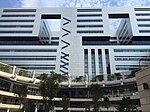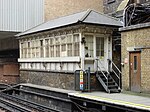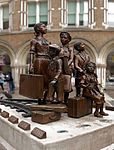Broad Street railway station (England)

Broad Street was a major terminal station in the City of London, adjacent to Liverpool Street station. It served as the main terminus of the North London Railway (NLR) network, running from 1865 to 1986. During its lifetime, it catered for mainly local suburban services around London, and over time struggled to compete with other modes of transport, leading to its closure. The station was built as a joint venture by the NLR and the London and North Western Railway (LNWR) in order to have a station serving freight closer to the City. It was immediately successful for both goods and passenger services and saw a significant increase in NLR traffic. Usage peaked in the early 20th century, after which it suffered from competition of London trams, buses, and particularly the London Underground network. Patronage gradually fell and services decreased, while the station building became increasingly dilapidated. Freight services were withdrawn towards the end of the 1960s and the station closed in 1986. The station building was replaced by Broadgate, an office and retail complex, while part of the connecting line to the station was reinstated as part of the London Overground.
Excerpt from the Wikipedia article Broad Street railway station (England) (License: CC BY-SA 3.0, Authors, Images).Broad Street railway station (England)
Broadgate Circle, City of London
Geographical coordinates (GPS) Address Nearby Places Show on map
Geographical coordinates (GPS)
| Latitude | Longitude |
|---|---|
| N 51.518888888889 ° | E -0.083333333333333 ° |
Address
Broadgate Circle Arena
Broadgate Circle
EC2M 2QS City of London
England, United Kingdom
Open on Google Maps










